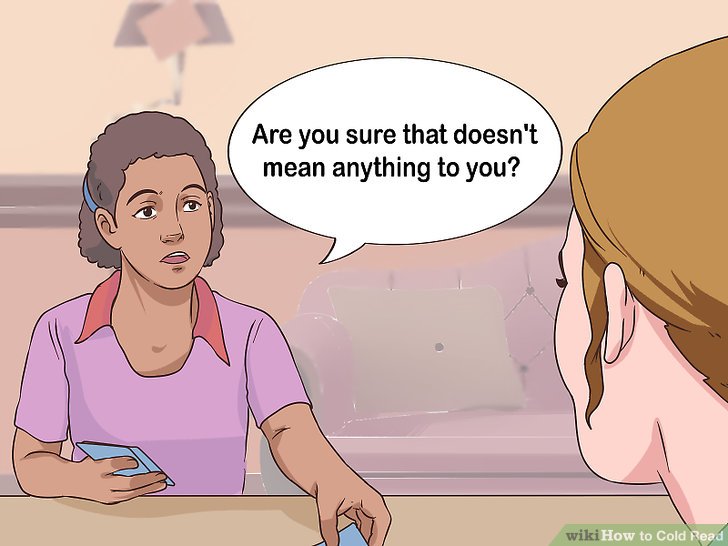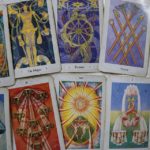“Cold reading” is a term used by mentalists and phony psychics and fortune-tellers. It describes the way they quickly assess a “mark” so they can appear to know a lot more than they actually do. (If the phony already knows facts about the mark, it’s a “hot reading.”)
Suppose you hear about a gifted psychic, someone like the heroine of “Medium.” You walk in the cold reader’s door, and the reader takes in your gender, age, race/ethnicity, social class, probable level of education, and dozens of other clues about you. Are you smart and skeptical, or naive and eager to believe? Do you look as though you have something on your mind, or do you look as though you’re consulting the psychic for fun? Your appearance offers dozens of clues about who you are and how easy or difficult it will be to impress you.
If you haven’t told the reader what you’re there about, she will probably continue with generalities that apply to almost everyone, while subtly trying to home in on what you’ve come wanting to hear. Then the cold reader will observe you carefully, without seeming as though she’s paying close attention. She’ll assess what you say, your body language, the movement of your eyes, how you’re breathing, and other clues.
The cold reader will probably begin by telling you something vague, like, “What I see often isn’t very clear to me, but I’m hoping it will be clearer to you.” For it to be a “good” cold reading, the mark must be unconsciously eager to help the “psychic” out. No cold reader likes a customer who just sits there and provides no feedback or other clues.
Most people who consult psychics are interested in love, money, health, career, their relationships, or travel.
A good cold reader will start with these. She’ll rapidly throw out a number of vague statements, and use your reactions to make her generalities seem much more specific. “I’m getting an impression of a woman — oh, a man, yes, a man, an older man — yes, an older man who cares about you in some way” — she sees you shrug — “not care about you in THAT way, a boss or a teacher, yes, a teacher who seemed not to care about you, but who had an impact on you.” Et cetera. If you’re the kind of customer cold readers like you’ll go home and tell your friends, “Wow, the psychic knew all about Mr. Bruce from the eighth grade, how he tortured me all year long but he was my all-time best middle school teacher!”
The cold reader will also ask questions that you might not perceive as questions; for example, “I’m getting the impression of a man whose name starts with J, like Joe or Jim. John? Jack? Or maybe there’s a J connected with this man, a wife or a daughter?” If it’s a hit, the cold reader will continue talking about your grampa Josh or your uncle Fred, whose wife’s name was Jane. If it’s a miss, the cold reader will rapidly proceed to other statement-questions.
Fish for details
 The third technique cold readers use is to fish for details. “I’m getting an impression of an older woman, a mother, an aunt, a grandmother, no, a teacher, a Sunday-school teacher. And there’s a blackness connected with her, her chest, no, her abdomen, her liver, her kidneys, her gall bladder, her spleen.” “My Sunday School teacher got appendicitis and had to be rushed to the hospital!” you exclaim. And off the cold reader goes.
The third technique cold readers use is to fish for details. “I’m getting an impression of an older woman, a mother, an aunt, a grandmother, no, a teacher, a Sunday-school teacher. And there’s a blackness connected with her, her chest, no, her abdomen, her liver, her kidneys, her gall bladder, her spleen.” “My Sunday School teacher got appendicitis and had to be rushed to the hospital!” you exclaim. And off the cold reader goes.
The cold reader might use “Barnum statements,” generalities that sound specific but that applies to almost everyone. “I sense you sometimes feel insecure, especially around people you don’t know very well.” “You have an old calendar you haven’t gotten rid of.” “You had an accident when you were a child that involved water somehow.” “You have a bunch of old photos that you haven’t put into albums.” “When you were a child in school, you knew a blonde girl in pigtails in a red dress who tattled on the boys to her mother.” Doesn’t everyone remember a blonde schoolgirl? Don’t most blondes have at least one red dress? Don’t all girls tattle on the boys to their mothers?
The cold reader might also use the “rainbow ruse,” in which one statement covers the whole spectrum of possibilities.
“At times you’re extroverted and sociable, but other times you’re shy and reserved. You seem very together and in control on the outside, but on the inside, you worry and feel insecure. You’re very independent, but you have a strong need for people to like you and to fit in with your crowd. You have some personality weaknesses, but you’re good at compensating for them. You are generous and kind, but when someone betrays your trust, you get angry and hurt.”
Sometimes through actual words, and sometimes through body language and other clues, a good customer will tell the cold reader all sorts of important information. Then the cold reader will cleverly use this information to tell the customer what the customer wants to hear. This is what cold reading is all about: Finding out what the customer is hoping the reader will say, and then saying it.
The Full Facts Book of Cold Reading
Mentalist Ian Rowland has written the best book available on the subject, “The Full Facts Book of Cold Reading.” One of his techniques he calls a “push statement,” a statement the mark is supposed to reject at first. Rowland writes about appearing on a TV show to demonstrate cold reading and telling the producers of the show about a shoe that might be connected to a man named Chuck or Charles, and something to do with a party. Everyone shook their heads; no, nothing, you’re totally off the mark, Mr. Rowland. Then after the production meeting, a young assistant excitedly told Rowland she had just remembered a party from when she was a teenager, at which she had danced with a boy named Charlie who had broken her shoe! The push statement had done its job.
Reading people’s palm
A psychologist named Ray Hyman earned extra money as a college student by reading people’s palms, even though he privately thought that palmistry was a bunch of hooey. So many of his customers gave him rave reviews, though, that he began to wonder whether he really WAS psychic. His psychology professor persuaded him to try an experiment: Tell your customers the OPPOSITE of what your textbooks say to tell them. Hyman was astonished to find that his feedback was more positive than ever. No matter what he told them, his customers figured out ways for him to be right.
In “The Wizard of Oz,” the wizard uses both cold reading and hot reading on Dorothy. In “Leap of Faith,” the Steve Martin character uses cold reading on a policeman to keep the cop from giving him a ticket. The hero of the TV series “Psych” uses cold reading in every episode.
The great secret of cold reading is that most people WANT to believe. They’ll remember the hits, and forget the misses and the errors. They’ll focus on statements they can make sense out of or see meaning in, and they’ll forget everything else.
You can practice cold reading by evaluating strangers you see on the evening news, or in the shops you go to. After hundreds of cold readings, you may get to be so good at it you’ll wonder if you’re psychic. Don’t worry, you’re not; you’re just a good judge of human nature. And that’s pretty good right there!






